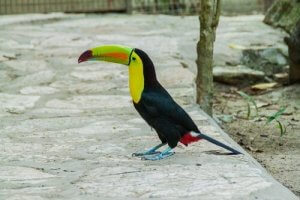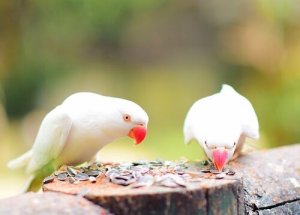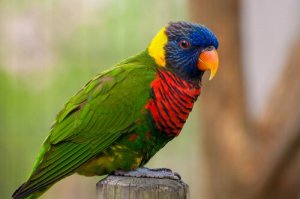Creating the Ideal Environment for Exotic Birds


Written and verified by the lawyer Francisco María García
Creating the ideal environment for exotic birds doesn’t just mean choosing the right cage. Taking care of a bird means recognizing and respecting your pet’s nutritional, hygiene and health needs.
Exotic birds in captivity
By buying some species of exotic birds, you may inadvertently be financing the illegal wildlife trade. Many countries have banned the keeping and breeding of any species of endangered animals.
Before buying particular species of exotic birds, it’s important to make sure that you’re legally allowed to own them. For example, toucans can’t be bred in captivity without a specific license. The sale and ownership of these animals could land you with huge legal penalties.

It’s also important to verify exactly where that animal has come from, and choose your supplier carefully. We wouldn’t recommend buying from individuals, or from unlicensed pet stores.
Choosing a cage for your exotic birds
Choosing the right cage is the first step to creating the ideal environment for your exotic birds. It should be a place where your pets feel safe enough to eat, sleep and mate.
The cage should be large enough to allow the animals to move around freely, and the layout should allow you to keep their environment clean fairly easily. For example, the food bowls should never come into contact with, or be in close proximity to, bird droppings. Otherwise, there’s a high risk of a parasitic infestation.
If you have the option of allowing your birds to roam freely around the house, the cage can be slightly smaller. Parrots, cockatoos, and parakeets can be easily trained to live freely and not escape. In these cases, the cage only needs to be 3 or 4 times the size of the bird.
Suitable living space
Allowing large or migratory birds to roam free in the house can be risky. It’s best to keep them in a cage or aviary, at least 6 or 7 times the size of the bird. We would recommend creating a spacious aviary, ideally with glass walls.
It’s important to make sure there are plenty of toys in your cage, to distract, entertain, and encourage your birds to exercise. Though very few people realize it, many domestic birds suffer from obesity, usually as a result of a poor diet and a sedentary lifestyle. Birds are very active animals, and can become restless or aggressive if they get bored.
Creating the ideal environment for exotic birds -diet
The right diet for your bird will vary from species to species. Birds can be carnivores, insectivores, granivorous or frugivores. Each species of bird is specially adapted for a particular type of diet, from the shape of their beaks, to their digestive system.
Dietary preferences will largely depend on the natural habitat of each species. Every ecosystem has a specific set of flora and fauna. The more hospitable the environment, the greater the variety and abundance of food available.
When it comes to the diet of a captive bird, it’s best to choose a complete pelleted bird food specifically designed for that particular species. These products offer a balanced diet of seeds, nuts, pulses, cereals, vitamins and minerals.
Experts recommend enriching your birds’ diet with a variety of fresh, natural ingredients (ideally organic). Just like their main diet, these will depend on the individual species.
Species and diet
Macaws are extremely prone to obesity. Pellets make up around 60-70% of their diet. This should be complemented with a variety of fruit and veg (roughly 25-30%) and nuts (5-10%).
Gray parrots need large amounts of minerals and calcium. Approximately 70-75% of their diet is made up of pellets, while 30% should be made up of fruit and veg.
Pellets should represent 75-80% of an Amazonian parrot’s diet. The remainder should be made up of fresh fruit and veg, and a small amount of seed.
Creating the ideal environment for exotic birds – hygiene
Birds are very clean animals. In captivity, they become vulnerable to both internal and external parasites. These micro-organisms can easily spread throughout the entire cage, infesting any toys and accessories.

As such, it’s important to clean their cage at least twice a week. Empty the bottom tray of any droppings, and remove any leftover food. You should also clean the food and water bowls thoroughly on a daily basis.
Don’t let rotting food or droppings build-up at the bottom of the cage, or in the food and water bowls. Any toys and accessories should be thoroughly disinfected on a regular basis to prevent the growth of fungi and bacteria.
In most pet stores, you’ll also find a range of specially designed products that’ll help you to combat many of the most common parasites found in birds. This is particularly important when it comes to red mites, which can cause serious damage to your pets’ skin and feathers.
Another good hygiene habit to get into is to check your birds’ feet, feathers and beak on a regular basis. If you notice any injuries, reddening, or signs of irritation, it’s important to book an appointment with a specialist avian vet as soon as possible.
Do all this, and you’ll be able to create the ideal environment for your exotic birds.
Creating the ideal environment for exotic birds doesn’t just mean choosing the right cage. Taking care of a bird means recognizing and respecting your pet’s nutritional, hygiene and health needs.
Exotic birds in captivity
By buying some species of exotic birds, you may inadvertently be financing the illegal wildlife trade. Many countries have banned the keeping and breeding of any species of endangered animals.
Before buying particular species of exotic birds, it’s important to make sure that you’re legally allowed to own them. For example, toucans can’t be bred in captivity without a specific license. The sale and ownership of these animals could land you with huge legal penalties.

It’s also important to verify exactly where that animal has come from, and choose your supplier carefully. We wouldn’t recommend buying from individuals, or from unlicensed pet stores.
Choosing a cage for your exotic birds
Choosing the right cage is the first step to creating the ideal environment for your exotic birds. It should be a place where your pets feel safe enough to eat, sleep and mate.
The cage should be large enough to allow the animals to move around freely, and the layout should allow you to keep their environment clean fairly easily. For example, the food bowls should never come into contact with, or be in close proximity to, bird droppings. Otherwise, there’s a high risk of a parasitic infestation.
If you have the option of allowing your birds to roam freely around the house, the cage can be slightly smaller. Parrots, cockatoos, and parakeets can be easily trained to live freely and not escape. In these cases, the cage only needs to be 3 or 4 times the size of the bird.
Suitable living space
Allowing large or migratory birds to roam free in the house can be risky. It’s best to keep them in a cage or aviary, at least 6 or 7 times the size of the bird. We would recommend creating a spacious aviary, ideally with glass walls.
It’s important to make sure there are plenty of toys in your cage, to distract, entertain, and encourage your birds to exercise. Though very few people realize it, many domestic birds suffer from obesity, usually as a result of a poor diet and a sedentary lifestyle. Birds are very active animals, and can become restless or aggressive if they get bored.
Creating the ideal environment for exotic birds -diet
The right diet for your bird will vary from species to species. Birds can be carnivores, insectivores, granivorous or frugivores. Each species of bird is specially adapted for a particular type of diet, from the shape of their beaks, to their digestive system.
Dietary preferences will largely depend on the natural habitat of each species. Every ecosystem has a specific set of flora and fauna. The more hospitable the environment, the greater the variety and abundance of food available.
When it comes to the diet of a captive bird, it’s best to choose a complete pelleted bird food specifically designed for that particular species. These products offer a balanced diet of seeds, nuts, pulses, cereals, vitamins and minerals.
Experts recommend enriching your birds’ diet with a variety of fresh, natural ingredients (ideally organic). Just like their main diet, these will depend on the individual species.
Species and diet
Macaws are extremely prone to obesity. Pellets make up around 60-70% of their diet. This should be complemented with a variety of fruit and veg (roughly 25-30%) and nuts (5-10%).
Gray parrots need large amounts of minerals and calcium. Approximately 70-75% of their diet is made up of pellets, while 30% should be made up of fruit and veg.
Pellets should represent 75-80% of an Amazonian parrot’s diet. The remainder should be made up of fresh fruit and veg, and a small amount of seed.
Creating the ideal environment for exotic birds – hygiene
Birds are very clean animals. In captivity, they become vulnerable to both internal and external parasites. These micro-organisms can easily spread throughout the entire cage, infesting any toys and accessories.

As such, it’s important to clean their cage at least twice a week. Empty the bottom tray of any droppings, and remove any leftover food. You should also clean the food and water bowls thoroughly on a daily basis.
Don’t let rotting food or droppings build-up at the bottom of the cage, or in the food and water bowls. Any toys and accessories should be thoroughly disinfected on a regular basis to prevent the growth of fungi and bacteria.
In most pet stores, you’ll also find a range of specially designed products that’ll help you to combat many of the most common parasites found in birds. This is particularly important when it comes to red mites, which can cause serious damage to your pets’ skin and feathers.
Another good hygiene habit to get into is to check your birds’ feet, feathers and beak on a regular basis. If you notice any injuries, reddening, or signs of irritation, it’s important to book an appointment with a specialist avian vet as soon as possible.
Do all this, and you’ll be able to create the ideal environment for your exotic birds.
This text is provided for informational purposes only and does not replace consultation with a professional. If in doubt, consult your specialist.








